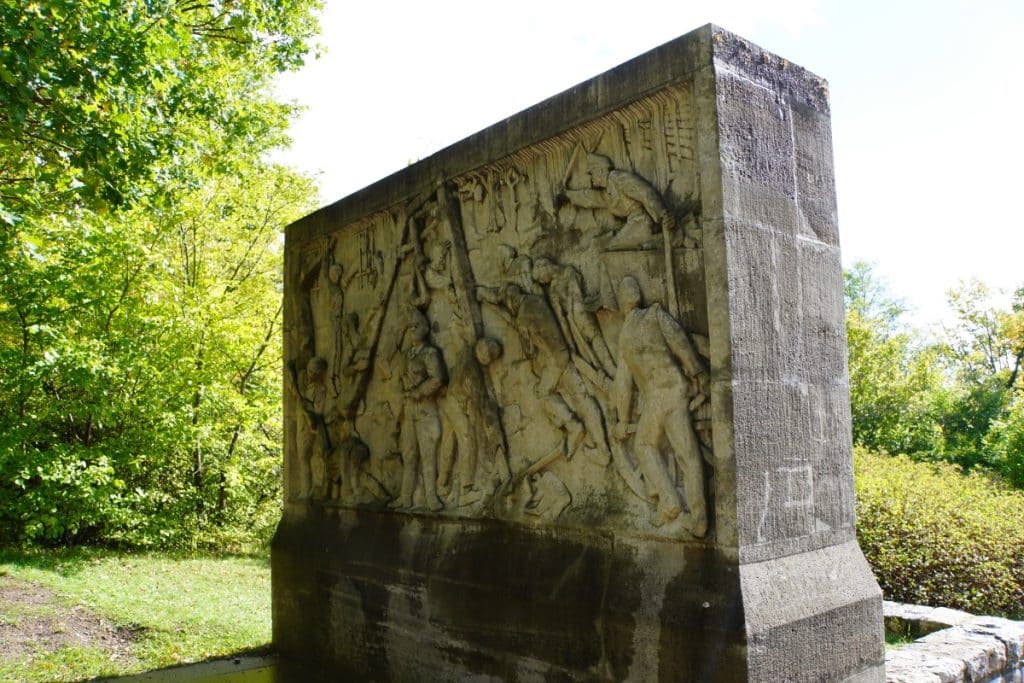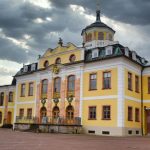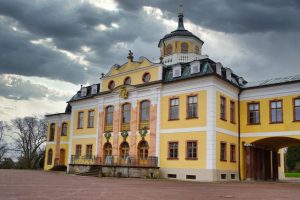The Buchenwald memorial near Weimar is visible far beyond the region and hopefully unforgettable. For us, it was a place that left a deep impression on us and made us very thoughtful. For us, it is a place that should not just be visited quickly, but should be consciously perceived.
There are simply places that stay with you long after a visit and that bring us closer to history than lessons at school ever could. One of these places is clearly the Buchenwald Memorial, which today is the largest memorial to a Nazi concentration camp in Europe. Here, on the Ettersberg, is the burial site of thousands of concentration camp inmates who lost their lives in the Buchenwald concentration camp.
Entrance to the memorial
Coming from the road, we reach a large open square with a stone gate on one side pointing the way. The view we have through the distant gate is beautiful. The valley below the Ettersberg opens up before us and the first houses of Weimar can be seen in the distance. As we get closer, we stand in front of a large flight of steps leading down. This staircase is made of red and black stones, laid in such a way that it only appears red when viewed from below.

To the side of the stairs are seven stone steles. Each of these steles symbolizes a year in which the Buchenwald concentration camp was in operation.
The steles are designed differently and show impressive relief depictions, each of which deals with a specific theme:
- Stele 1: “Construction of the camp”
- Stele 2: “Arrival of the prisoners”
- Stele 3: “Hard labor in the quarry”
- Stele 4: “Suffering and extermination of the prisoners”
- Stele 5: “Solidarity despite suffering and extermination”
- Stele 6: “Thälmann celebration and preparation for resistance”
- Stele 7: “The liberation”

On the back are verses written by the then GDR Minister of Culture, Johannes R. Becher.
You should take the time to look at the relief depictions a little more closely. It is noticeable that the political orientation of the GDR government has been incorporated into the design. During the GDR era, the resistance of the concentration camp prisoners against the SS symbolized the struggle of communism against fascism. This can be seen quite clearly.
Bell tower and group of figures
We weren’t initially drawn all the way down, we wanted to see the bell tower and the group of figures standing in front of it first. Actually the “wrong” way, as I found out afterwards. When the Buchenwald memorial was designed, this place was actually intended to be the end point of the path.
On paths along grassy areas and under shady trees, we finally reached the large open space in front of the bell tower.

The bell tower is over 50 meters high and made of light sandstone. Inside, earth and ashes from European concentration camps and Nazi terror sites have been placed under a bronze plate. Unfortunately, during our visit it was not possible to get inside the tower to commemorate the dead.
Two staircases lead up to a platform below the Buchenwald bell. This is supposed to be rung every hour, but I didn’t hear it during our time there, or perhaps I just missed it.
Directly in front of the bell tower, at the end of the large square, stands a large, impressive group of figures. Fritz Cremer created this bronze sculpture, which shows the “self-liberation” of the concentration camp prisoners under the leadership of the communists.

There are 11 figures who embody different characters. The central figure is a man (the “caller”) who urges the prisoners to free themselves. On the right-hand side of the group are the figures who embody the doubts about the success of the action. A child is also depicted, representing the many children in the concentration camp. This boy appears determined and ready to rebel against the ruling powers.
The bell tower and the group of figures form a really impressive picture. I can somewhat understand why mass events (e.g. swearing-in ceremonies for soldiers) were held here in GDR times, even if I personally think it is the wrong place for self-expression of any kind. Such incomprehensible acts took place on this site that it should not be used for political events, but at most for commemorative events.
Ring graves and the Avenue of Nations
We leave the square in front of the bell tower via the steps in front of the group of statues. A wonderful view of Thuringia opens up in front of us, as well as a view of three round funnels in the ground, which are surrounded by stone walls.
These funnels in the ground are mass graves in which the SS buried around 3,000 dead in 1945. They were mainly Hungarian Jews who had been transported from Auschwitz to Buchenwald.

When the plans for the Buchenwald Memorial were being drawn up, only the locations of two mass graves were known. It was only during the work on site that the third grave was discovered and the site was then extended.
During the construction of the memorial, the workers built Roman-style circular walls around the mass graves with openings that made it possible to enter. A place that at first seems to me like a place of power, whose boundaries are defined by the walls. It is only when I realize that this is the final resting place for many people that I feel the confining walls as restrictive, hardly allowing a way out.

The “Road of Nations” runs between the ring graves. Towards the valley are 18 pylons with fire bowls. Each pylon is marked with the name of a nation from which people were deported to Buchenwald concentration camp. An impressive path, which is sure to be a dignified reminder of the dead with its burning bowls at dusk.

I was very impressed by my visit to the Buchenwald Memorial. It wasn’t just the architectural design and the size that left a lasting impression on me. The historical background and the commemoration of the many victims of that time also left a lasting impression on me.
Address:
Buchenwald,
99427 Weimar
How to get there
By bus
From Goetheplatz in Weimar and from the main train station, bus line 6 runs every hour in the direction of Buchenwald, with a journey time of around 20 minutes.
At weekends, bus line 4, which runs in the direction of Ettersburg, also offers connections to the memorial, which is located around 10 km northwest of Weimar city center.
By car:
Via the A4 highway (Frankfurt am Main – Dresden), take exit 48 “Nohra”, drive in the direction of Weimar and follow the signs to the Buchenwald Memorial for a distance of around 18 km.
From the A9 highway (Berlin – Munich), change to the A4 at the Hermsdorfer Kreuz junction in the direction of Jena / Erfurt / Frankfurt am Main. After approx. 40 km you will reach exit 48 “Nohra”, from where the Buchenwald Memorial is signposted, also 18 km away.
Travelers on the A71 freeway (Schweinfurt – Sömmerda) take the A4 towards Jena / Dresden at the Erfurter Kreuz junction. After about 20 km, take exit 48 “Nohra”, from where the Buchenwald Memorial is signposted after 18 km.
Take the B7 (Kassel – Erfurt – Gera) or the B85 (Kyffhäuser – Bayreuth) and follow the signs at Weimar directly to the Buchenwald Memorial.
Parking
A large number of free parking spaces are available.
The photos are used with the permission of the Buchenwald and Mittelbau Dora Memorials Foundation.








Leave a Reply